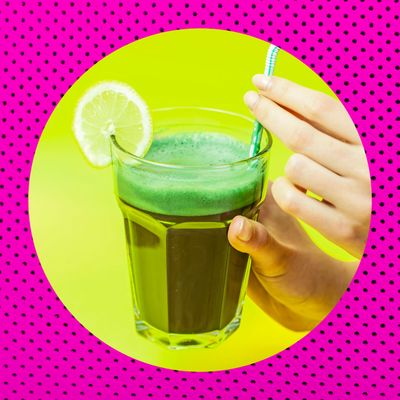
“Hot Bod” is an exploration of fitness culture and its adjacent oddities.
If I’ve noticed one thing about invitations to parties in the Hamptons — where I have never been — it’s that they lead with the drinks. I cherish and study these invites, because they contain universes. A wine yacht serving gin oyster shooters? Fascinating, must decline. Patio with jalapeño shrub cocktails? Yes, but no. A month or so ago, I woke up to an email invitation to an abbreviated wellness retreat in a sculpture garden that was serving collagen vitamins and, to drink, Athletic Greens. Unfortunately, I couldn’t be persuaded.
Then, for the rest of the summer, I heard about this dank green drink relentlessly. It seems to be the everyday cure-all liquid among the wellness retreat types. “Adore Athletic Greens,” a delightful know-it-all acquaintance texts me. I find out she hasn’t tried it yet, but she did hear about it on her favorite wellness podcast. A friend’s frighteningly fit younger brother is in talks with the company to purchase a lifetime supply. I then hear about it on POOG; host Kate Berlant sounds absolutely exhausted about the daily commitment to anything. I find out that (of course) Peloton powerhouse Robin Arzon, who mentioned the drink in the New York Times a few years ago, is an investor, as are Hugh Jackman, Cindy Crawford, Olympian gymnast Shawn Johnson, and Steve Aoki. Like the drink itself, its genuine saturation in the wellness space seems hazy, but potentially potent.
The look of Athletic Greens is opaque, sizzling silty green, and its promise equally fuzzy. Is this a powdered green juice specifically for athletes? Do these greens just make you feel athletic? Do the greens work in a very sporty, fast way? The powdery mix contains a heaping 75 vitamins, probiotics, prebiotics, digestive enzymes — and a vaguely competitive promise. The powder offers four grams of protein, so about a third of a typical protein-forward drink, but about twice that of a typical green juice and its attenuating vitamin blast. To summarize my friend, who suggested that Athletic Greens tastes like the uncanny valley of morning smoothie: “It’s like a robot got a recipe for a pressed juice mixed with a protein shake.”
As for the name, the Green part is from the spirulina and the Athletic part was a mistake, says founder Chris Ashenden. He tells me he’s worried this communicates the drink is only for athletes, when it’s for everyone on the planet. “But in the end, the world wants to be more robust,” Ashenden tells me, “they want to feel amazing.” They want to feel the way it seems like an athlete would feel on the inside.
In terms of delivery on promises (general energy, gut perfection), the results are classically unknown and subjective. I take it for a few weeks, and as always, I have my mix of days. But I’d forgotten that when you’re trying a new panacea, it’s very fun to blame it for your failures (how dare I be tired after a full night’s sleep) and then credit it for every little success (wow, am I lifting this 40-pound bag of garden soil like a genius?).
To assess Athletic Greens as a delivery system (the liquid itself), here’s a big twist in that river: I did not mind how it tasted! (Two friends of mine and my partner strongly disagreed.) My defense is that Athletic Greens is earthy, probably from the mushroom complex, a little chalky, a little mossy. It tastes like soccer practice and grass, a little salty, outdoorsy. Dare I say, it tastes … athletic?
And on days when I didn’t work out, but I had my juice (“juice”), I almost felt like I had worked out! Can you imagine a placebo that makes you feel sporty when you haven’t done anything? I mean, it could sell for a million dollars. In fact, Athletic Greens sells for $99 for a 30-day supply. It’s also meant to be taken infinitely. Like every day forever. Like exercise regimens, Athletic Greens is one of those things that’s so assured of its one beneficent power, it is destined to become a daily habit. But, as always, I’m only here to dabble. Also, I have to shake the powder in water for 20 seconds every time, and I am convinced my left arm is getting more swole than my right.
To really understand Athletic Greens, I needed to remind myself that a drink is also an adornment, an accessory, a prompt, something to carry around, something to absorb. What Athletic Greens oozes is a type of holistic easiness. As neon Gatorade bottles signaled sweaty endurance and pushing limits in the “Just Do It” era of the ’90s, it makes sense that the current drink to communicate elite physicality would be more “well-rounded” in its promises. Athletic Greens seems more natural, “cleaner,” the color of “real food.” And while the vitamins and probiotics doubtlessly surge through the drink, working untold magic on the interior, the external signal of Athletic Greens also provides a potent appeal to investors and consumers alike.
A few days into my routine, I ask my women’s health Ph.D. pal to come over to soothe my wariness. My friend, who is no stranger to trying wellness fads and actually came over with an acupuncture thing in her ear, picks up the box and shrugs. “Just eat food,” she says, and puts it down. Athletic Greens is just the nutrients in my gazpacho and summer veggie bonanza dinner reduced to their chemical parts. It is nutrition at its most streamlined and optimized. It’s easy to get cynical about optimization these days, but happily, it’s also still pretty easy to get curious about some opaque, liquid promises that you learned about from a party you don’t regret not going to.




